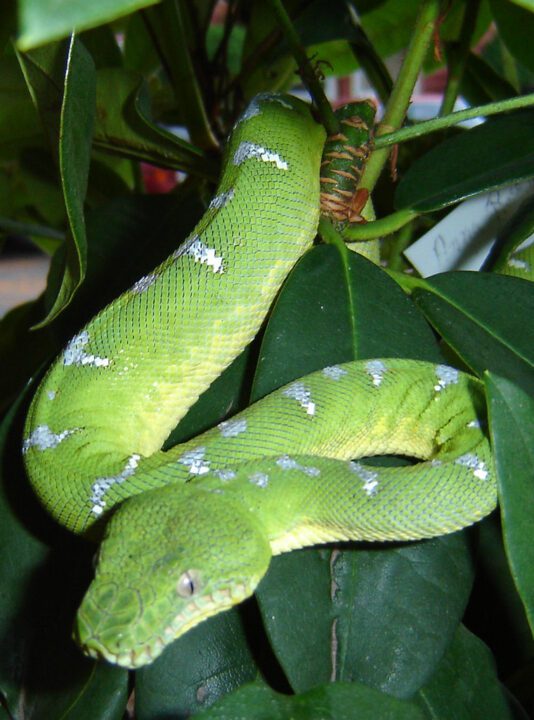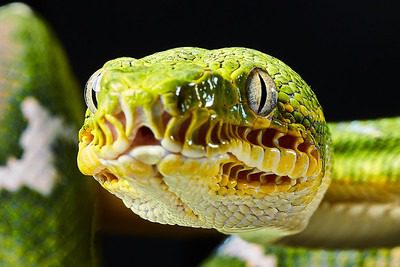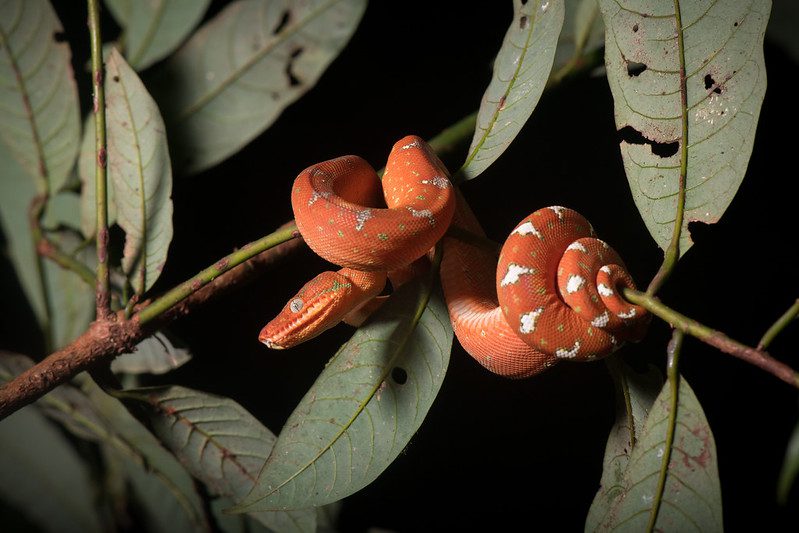The emerald tree boa (Corallus caninus) is a visually striking and biologically fascinating snake species native to the rainforests of South America. Known for its vivid green scales and dramatic appearance, the emerald tree boa has captivated herpetologists, exotic pet enthusiasts, and nature lovers alike. This comprehensive guide delves into every major aspect of the emerald tree boa, organized by keyword relevance and thematic significance.
Overview of the Emerald Tree Boa
What is an Emerald Tree Boa?
The emerald tree boa is a non-venomous constrictor species belonging to the family Boidae. It is renowned for its vibrant green coloration and white dorsal markings, which provide camouflage in its arboreal habitat. This snake is solitary, nocturnal, and highly adapted to life in the trees.

Unique Traits and Unusual Facts
- It exhibits a striking color change from birth to adulthood: juveniles are typically red, orange, or yellow and gradually turn green as they mature.
- Its prehensile tail is a specialized adaptation for climbing and anchoring to branches.
- Despite its name, it is not closely related to the green tree python, though they share similar ecological niches and appearances.
Physical Characteristics
Emerald Tree Boa Size
Emerald tree boas are medium-sized snakes. Adults typically range from 4 to 6 feet in length, though some individuals can exceed 7 feet. Females tend to be larger and heavier than males.
- Average length: 4–6 feet
- Maximum recorded length: ~7 feet
- Weight: 1.5–3.5 pounds
Their robust body and strong musculature enable them to grasp and constrict prey effectively.
Emerald Tree Boa Teeth
One of the most fascinating features of the emerald tree boa is its teeth. They possess some of the longest teeth among non-venomous snakes relative to body size.
- Long, recurved teeth help them catch birds and mammals from tree branches.
- Their teeth are designed to grip prey securely during constriction.
- These snakes strike with lightning speed, often hanging from branches when ambushing.
Emerald Tree Boa Yawning
Yawning is commonly observed in emerald tree boas. While it may appear as a form of stretching, it serves multiple purposes:
- Realigning the jaw after feeding.
- Resetting the glottis for breathing.
- Possibly aiding in stress relief or behavioral communication.
This seemingly unusual behavior is normal and not typically a sign of illness.

Habitat and Geographic Range
Emerald Tree Boa Habitat
Emerald tree boas are endemic to the tropical rainforests of South America, particularly in the Amazon Basin.
- Found in countries like Brazil, Colombia, Peru, Venezuela, and Ecuador.
- Prefers humid, densely vegetated forest canopies.
- Rarely descends to the forest floor except during occasional hunting or breeding behaviors.
Their habitat must maintain high humidity levels and consistent temperatures, mirroring their tropical origins.
Amazon Basin Emerald Tree Boa
The Amazon Basin emerald tree boa is a specific locale variation known for its:
- Larger size compared to northern variants.
- More pronounced and irregular white markings.
- Generally calmer temperament in captivity.
This morph is highly prized among reptile enthusiasts for its beauty and relative docility.
Northern Emerald Tree Boa
Another geographic variation, the northern emerald tree boa, is found primarily in the northern regions of South America.
- Smaller and often more temperamental.
- Features a more linear white pattern.
- Faster metabolism and more aggressive feeding behavior.
These distinctions are important for breeders and conservationists to note.
Behavior and Lifestyle
Emerald Tree Boa Diet
Emerald tree boas are carnivorous predators with a highly specialized diet.
- Primary diet: Small mammals (like rodents), birds, and occasionally lizards.
- Hunting method: Ambush predator, using camouflage and sudden strikes.
- Feeding frequency: Every 1–2 weeks in the wild; varies in captivity.
They rely heavily on their heat-sensing pits to detect warm-blooded prey in low-light conditions.
Emerald Tree Boa Predators
Despite being formidable hunters, emerald tree boas do have natural predators:
- Large birds of prey (e.g., harpy eagles)
- Jaguars and other big cats
- Humans (due to deforestation and illegal pet trade)
Their camouflage is their primary defense mechanism, and their high perch location provides relative safety.
Baby Emerald Tree Boa
Emerald tree boas give birth to live young rather than laying eggs—a trait shared by many boas.
- Litters range from 5 to 20 neonates.
- Babies are born brightly colored: red, yellow, or orange.
- They become fully independent almost immediately.
The vibrant juvenile colors serve as camouflage among the red and yellow forest leaves.
Color Variations and Morphs
Blue Emerald Tree Boa
Rare and highly sought after, blue emerald tree boas exhibit a bluish hue due to selective breeding or genetic mutation.
- Considered extremely rare in the wild.
- High value in the exotic pet trade.
- Often the result of specific breeding programs.
These snakes are not a separate species but a color morph with similar care needs and behavior.
Green Emerald Tree Boa / Emerald Green Tree Boa
These names are often used interchangeably with the standard emerald tree boa.
- Refers to the species’ iconic emerald green color.
- Variations in green intensity may indicate different locales or health status.
- Green coloration is key to its survival strategy in the canopy.

Comparative Analysis
Emerald Tree Boa vs Green Tree Python
One of the most common comparisons is between the emerald tree boa and the green tree python (Morelia viridis).
Similarities:
- Both are arboreal constrictors.
- Possess striking green coloration.
- Share similar diets and habitats.
- Use similar resting posture: coiled on branches with head in center.
Differences:
- Emerald tree boa is native to South America; green tree python is from New Guinea and northern Australia.
- Boas give live birth; pythons lay eggs.
- Boas have heat-sensing pits on their upper lip; pythons on their lower jaw.
Green Tree Python vs Emerald Tree Boa
When considered from the green tree python perspective, the distinctions remain equally pronounced.
- Pythons tend to have a more slender body.
- Python hatchlings are often yellow or red; similar to boas.
- Green tree pythons have become more widespread in captivity due to easier breeding.
Fascinating Emerald Tree Boa Facts
- Lifespan: Up to 20 years in the wild; longer in captivity.
- Vision: Though they are nocturnal, they have well-developed vision and infrared detection.
- Behavior: Generally sedentary, conserving energy between feedings.
- Defensive posture: Will form an S-shape coil and strike if threatened.
- Camouflage: Their pattern and coloration make them nearly invisible among foliage.
Conservation and Human Interaction
Current Conservation Status
Emerald tree boas are not currently listed as endangered, but they are affected by:
- Habitat loss due to logging and deforestation.
- Illegal collection for the exotic pet trade.
- Climate change impacting rainforest ecosystems.
Conservation efforts focus on habitat preservation and stricter trade regulations.
In Captivity
Emerald tree boas are popular in the exotic pet industry, but they require experienced care:
- High humidity (~80%) and temperature (~78–85°F)
- Vertical enclosures with climbing structures
- Regulated feeding schedules to prevent obesity or regurgitation
Captive breeding helps reduce wild collection but must be managed responsibly.
Final Thoughts
The emerald tree boa is a testament to the wonders of evolution, adaptation, and beauty in the animal kingdom. With its dazzling coloration, unique behaviors, and impressive physical adaptations, this snake continues to intrigue scientists and hobbyists alike. As interest in reptiles grows and ecosystems face increasing pressure, understanding and appreciating species like the emerald tree boa becomes all the more vital.
Whether you’re captivated by its hypnotic green coils, fascinated by its predatory prowess, or intrigued by its role in tropical ecosystems, the emerald tree boa remains one of the most iconic serpents of the rainforest canopy.










